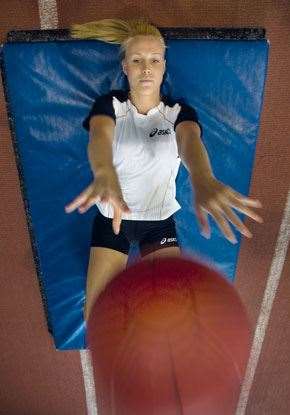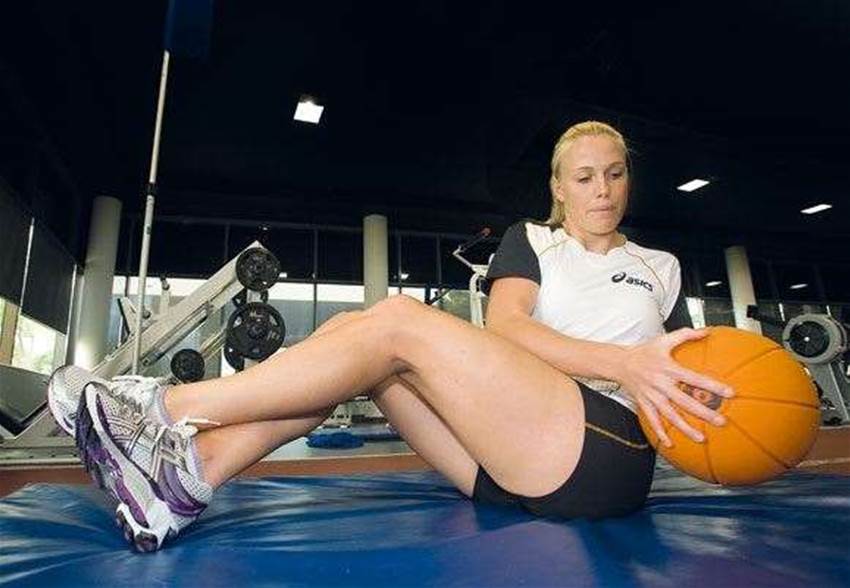Over the off-season the girls have been sweating out the nightmares of ’09. Here, powerhouse centre Kimberlee Green reveals the regime that aims to drag the Swifts back to the peak of the ANZ
 Power play Images: Warren Clarke
Power play Images: Warren ClarkePower play
“The make-up of our personal gym program depends on our weaknesses or needs. Personally, I’m a power player; even though I play centre and run quite a bit during a game, I’m an explosive centre as opposed to a long-running centre, so the gym work I do is strength-based with a fair bit of power popped in.“We start with a warm-up – light calf raises and very light dumbbell movements to warm our arms. After that we move into squats. We’ll start with a heavy box squat [lowering onto a box then pushing off from the seated position], then do a power jump set in between the squats – that way we build both strength and power. The box squat is good because you get good depth on the movement, but you also have to display control moving up and down.
“For the power set we jump up onto a medium-sized box, say 60cm high. We hold a dumbbell in each hand and then release it at the lowest point of the jump. It’s called a ‘release jump’ – it’s similar to a jump squat – and it’s great for explosive power. The reps obviously change at different points of the season, but at the moment, heading into the season, we’re doing four sets of five reps on both the squats and power sets.“Staying on our legs, we also do a lot of static lunges with the bar held across our shoulders. At the moment we’re working eight reps on each leg for four sets. In between the lunge sets we do an exercise called Nordic lowering, where you kneel down, secure your feet against a wall, then lean as far forward as you can. It really hits the hammies and gluts.“At the moment we’re not doing a lot of upper body work – we normally don’t target our upper bodies until we really get into our on-court work. In-season we’d be doing a lot of bench press and bench pull, using quite a heavy load. As with the legs, in between those heavy bench sets we’d move into a power set. A common power exercise is to lie on your back, holding a medicine ball on your chest, and throw the ball as high in the air as you can. We normally start our upper body work a month or two out from the start of the season.”
En court!
“We always start a court session with a dynamic warm-up – a lot of running, sliding, skipping; basically any movement to get the body warm. We don’t do a lot of static stretching, instead we’ll incorporate movement into the stretches. So, for example, we’ll walk three steps, stretch our left hamstring, walk three steps, stretch our right hamstring … From there we’ll go into some one-on-one ball work where we pair up and go through the motions we’ll use on court – chest passes, shoulder passes, etc.“After that we go into some game-specific agility work. During the pre-season this agility work has a heavy fitness emphasis. We’ll have, say, five sequences of different coloured cones lined out, and we’ll get into pairs and run through the sequences. Within these sequences there are around five typical movements – clearing around a cone, breaking left, breaking right, etc – with passing thrown in. All the cones are colour coded – just makes it a bit easier to follow. It’s one-on, one-off; your recovery is the time it takes your partner to do the sequence, so it’s not much of a break. We normally do around five sets of these sequences.”
Getting drilled
“During the pre-season we work continuous drills in 15-minute blocks. This gets our match fitness up, gets us used to playing in 15-minute blocks (games are divided into 15-minute quarters). We’ll work these drills in the middle third of the court, the squad divided up into four groups, each group lined up at the corners of the square.“From here, the drills are generally pretty simple. For example, you face the group diagonally opposite you, run towards them, receive a pass on your right-hand side, then off-load that ball to the person you’re running towards. Essentially it’s a crossover drill. It’s all about running the right lines, placing the ball perfectly, knowing who you’re passing the ball to, knowing how far they can reach … After each run we’ll normally get a five-second rest and we’ll just run that drill over and over for 15 minutes. The lactic acid builds very quickly, so we have to push through that. It’s great for honing match fitness.“After that the squad will break up and we’ll all work on our specific games. I’ll go to the mid-court and work a lot of reactive balls around the circle. Of course, in netball, the mid-courters can’t go in the circle, so we do a lot of work driving onto the circle, particularly the top of the circle directly in line with the post. I’ll work at driving toward that spot, then receiving a lot of sharp reactive passes on the edge of the circle. That’s essentially the basis of mid-court work – receiving and placing balls around that circle without going off-side.“After that we’ll bring the squad together. In most training sessions there’s a specific structure we’ve been working on, so we all know what the other groups – the shooters, the defenders – have been focussing on. This makes our game-situation training much tougher and generally forces us to put some personal finesse into our play. The games are normally half-court, the attackers bringing the ball down court, the defenders trying to intercept it and take it back to the halfway line, just like a half-court basketball game.”
Related Articles

Viva Las Vegas: Join Golf Australia magazine's Matt Cleary on a golf and rugby league spectacular

19 Holes With ... Chad Townsend and Val Holmes







.jpg&h=115&w=225&c=1&s=1)





